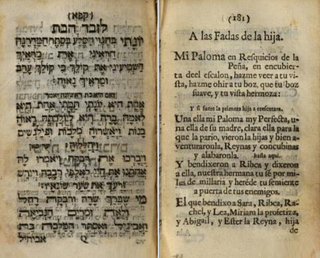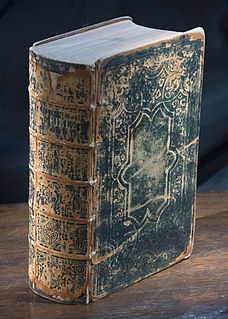Related Research Articles

The Mishnah or the Mishna is the first major written collection of the Jewish oral traditions which is known as the Oral Torah. It is also the first major work of rabbinic literature. The Mishnah was redacted by Judah ha-Nasi at the beginning of the 3rd century CE in a time when, according to the Talmud, the persecution of the Jews and the passage of time raised the possibility that the details of the oral traditions of the Pharisees from the Second Temple period would be forgotten. Most of the Mishnah is written in Mishnaic Hebrew, but some parts are in Aramaic.

The role of women in Judaism is determined by the Hebrew Bible, the Oral Law, by custom, and by cultural factors. Although the Hebrew Bible and rabbinic literature mention various female role models, religious law treats women differently in various circumstances.

Shlomo Yitzchaki, today generally known by the acronym Rashi, was a medieval French rabbi and author of a comprehensive commentary on the Talmud and commentary on the Hebrew Bible. Acclaimed for his ability to present the basic meaning of the text in a concise and lucid fashion, Rashi appeals to both learned scholars and beginner students, and his works remain a centerpiece of contemporary Jewish study. His commentary on the Talmud, which covers nearly all of the Babylonian Talmud, has been included in every edition of the Talmud since its first printing by Daniel Bomberg in the 1520s. His commentary on Tanakh—especially on the Chumash —serves as the basis for more than 300 "supercommentaries" which analyze Rashi's choice of language and citations, penned by some of the greatest names in rabbinic literature.

The Torah is the compilation of the first five books of the Hebrew Bible, namely the books of Genesis, Exodus, Leviticus, Numbers and Deuteronomy. In that sense, Torah means the same as Pentateuch or the Five Books of Moses. It is also known in the Jewish tradition as the Written Torah. If meant for liturgic purposes, it takes the form of a Torah scroll. If in bound book form, it is called Chumash, and is usually printed with the rabbinic commentaries.
A rabbi is a spiritual leader or religious teacher in Judaism. One becomes a rabbi by being ordained by another rabbi – known as semikha – following a course of study of Jewish texts such as the Talmud. The basic form of the rabbi developed in the Pharisaic and Talmudic eras, when learned teachers assembled to codify Judaism's written and oral laws. The title "rabbi" was first used in the first century CE. In more recent centuries, the duties of a rabbi became increasingly influenced by the duties of the Protestant Christian minister, hence the title "pulpit rabbis", and in 19th-century Germany and the United States rabbinic activities including sermons, pastoral counseling, and representing the community to the outside, all increased in importance.

Rabbinic literature, in its broadest sense, is the entire spectrum of rabbinic writings throughout Jewish history. However, the term often refers specifically to literature from the Talmudic era, as opposed to medieval and modern rabbinic writing, and thus corresponds with the Hebrew term Sifrut Chazal. This more specific sense of "Rabbinic literature"—referring to the Talmudim, Midrash, and related writings, but hardly ever to later texts—is how the term is generally intended when used in contemporary academic writing. The terms meforshim and parshanim (commentaries/commentators) almost always refer to later, post-Talmudic writers of rabbinic glosses on Biblical and Talmudic texts.

A scribe is a person who serves as a professional copyist, especially one who made copies of manuscripts before the invention of automatic printing.
ArtScroll is an imprint of translations, books and commentaries from an Orthodox Jewish perspective published by Mesorah Publications, Ltd., a publishing company based in Rahway, New Jersey. Rabbi Nosson Scherman is the general editor.

Pirkei Avot, which translates to English as Chapters of the Fathers, is a compilation of the ethical teachings and maxims from Rabbinic Jewish tradition. It is part of didactic Jewish ethical literature. Because of its contents, the name is sometimes given as Ethics of the Fathers. Pirkei Avot consists of the Mishnaic tractate of Avot, the second-to-last tractate in the order of Nezikin in the Mishnah, plus one additional chapter. Avot is unique in that it is the only tractate of the Mishnah dealing solely with ethical and moral principles; there is relatively little halakha (laws) in Pirkei Avot.
According to Rabbinic Judaism, the Oral Torah or Oral Law are those purported laws, statutes, and legal interpretations that were not recorded in the Five Books of Moses, the Written Torah, but nonetheless are regarded by Orthodox Jews as prescriptive and given at the same time. This holistic Jewish code of conduct encompasses a wide swathe of rituals, worship practices, God–man and interpersonal relationships, from dietary laws to Sabbath and festival observance to marital relations, agricultural practices, and civil claims and damages.

A Sefer Torah or Torah scroll is a handwritten copy of the Torah, meaning the five books of Moses. The Torah scroll is mainly used in the ritual of Torah reading during Jewish prayers. At other times, it is stored in the holiest spot within a synagogue, the Torah ark, which is usually an ornate curtained-off cabinet or section of the synagogue built along the wall that most closely faces Jerusalem, the direction Jews face when praying.

Zeved habat or Simchat Bat is the Jewish naming ceremony for newborn girls. The details of the celebration varies somewhat by Jewish community and will typically feature the recitation of specific biblical verses and a prayer to announce the name of the newborn child.
Torah reading is a Jewish religious tradition that involves the public reading of a set of passages from a Torah scroll. The term often refers to the entire ceremony of removing the scroll from the Torah ark, chanting the appropriate excerpt with special cantillation (trope), and returning the scroll(s) to the ark. It is also commonly called "laining".

Chumash is a Torah in printed and book bound form as opposed to a Sefer Torah, which is a scroll.

Disputes regarding the internal consistency and textual integrity of the Bible have a long history.
Chazal or Ḥazal, an acronym for the Hebrew "Ḥakhameinu Zikhronam Liv'rakha", refers to all Jewish sages of the Mishna, Tosefta and Talmud eras, spanning from the times of the final 300 years of the Second Temple of Jerusalem until the 7th century CE, or c. 250 BCE – c. 625 CE.
Jewish commentaries on the Bible are biblical commentaries of the Hebrew Bible from a Jewish perspective. Translations into Aramaic and English, and some universally accepted Jewish commentaries with notes on their method of approach and also some modern translations into English with notes are listed.

Sifrei Kodesh, commonly referred to as sefarim, or in its singular form, sefer, are books of Jewish religious literature and are viewed by religious Jews as sacred. These are generally works of Torah literature, i.e. Tanakh and all works that expound on it, including the Mishnah, Midrash, Talmud, and all works of halakha, Musar, Hasidism, Kabbalah, or machshavah. Historically, sifrei kodesh were generally written in Hebrew with some in Judeo-Aramaic or Arabic, although in recent years, thousands of titles in other languages, most notably English, were published. An alternative spelling for 'sefarim' is seforim.
An aliyah is the calling of a member of a Jewish congregation to the bimah for a segment of Torah reading.
Yihye Bashiri, also spelt Yahya al-Bashiri, known by his pen-name Avner bar Ner ha-Sharoni, and by the acronym Maharib, was a Yemenite Rabbi, professional scrivener and sofer of the Masoretic Text whose works of Hebrew manuscripts now account for many now stored in public libraries across the globe, including the Jewish Theological Seminary of America, Cambridge University Library, the Russian State Library and the Hebrew Union College-Jewish Institute of Religion, et al. Rabbi Yiḥyah Salaḥ coined him the epithet, "the great scribe of the Law." A man of uncommon piety, he is also known for an act of intervention on behalf of his community in Yemen, which brought miraculous deliverance to the Jews of Sana'a when they stood in danger of annihilation by the king, on account of libel and slander brought against them.
References
- ↑ Emily Taitz, Sondra Henry & Cheryl Tallan, The JPS Guide to Jewish Women: 600 B.C.E.to 1900 C.E. , 2003.
- ↑ "Learned Women in Traditional Jewish Society".
